Added 12-9-02
Updated 9-11-08
This page was inspired after Mike Sparks of the Airborne Equipment Shop drew my attention to the following article.
My initial response was that it was desirable to use some agent other than non-specific herbicides or defoliants. One can't encourage people to grow crops instead of drugs if you have rendered their ecosystem unsuitable for both. For example, Jamaica is responsible for growing what is reputably some of the best marijuana in the world, but the same areas also grow some of the world's most sought after coffee. Use of non-specific herbicides in Jamaica would be both an ecological and economic disaster.
The war against drugs may in fact be legitimate application for biological warfare. There are doubtlessly various natural plant pathogens that only effect the opium poppy, coca plant or marijuana bush. Loading spray planes with a mixture of these will eliminate narcotics yielding plants with less environmental impact. Such agents can even be used for speculative spraying where target plants are suspected but not confirmed. Another possibility is that enzymes may be possible that destroy or denature the active ingredients in narcotic crops.
This train of thought made me consider suitable characteristics for a counter-narcotic (Conarc) aircraft. Many of the desirable features listed for Counter-insurgency aircraft on the Buzzard page are equally applicable to the Conarc planes. The main differences is that the Conarc plane needs to be capable of crop spraying, and that speed is not such a crucial requirement, since fields of plants are less mobile than terrorists.
The ideal plane that I imagine for the Conarc role resembles a smaller version of the wartime Westland Lysander III.
The aircraft will carry a pilot and co-pilot/observer and be armoured. Given the areas that such a plane is likely to operate in, STOL and rough field capability is a major priority, and for this reason I'm going to suggest that the aircraft be of a sesquiplane configuration. This means that it is a biplane with a diminutive lower wing. This was used on various Nieuport biplanes.
The Junkers J-1 ground attack plane also used sesquiplane configuration and it was found that this gave good downward visibility for both the pilot and observer.
The lower wing would contain tanks to hold some of the spraying agent and have hardpoints for weapons. This wing provides some shielding for the upper wing. It also makes the aircraft easier to rearm than a conventional high wing monoplane. The upper wing might have hardpoints for non-dropped ordinance such as gun and rocket pods. FN Herstal makes the RMP, a lightweight .50 MG pod with 250rds and three 2.75” Rockets. Also offered by the same company is the HMP-RL, a four shot 2.75” Rocket launcher that fits to the bottom of their 250 and 400 round HMP250/400 .50 MG pods. A weapon such as the .50 Gecal could be fired from the Cabin door and used for Orbiting fire.
The proposed aircraft may end up looking something like the very successful Beech 17 Staggerwing. The Griffon Lionheart is a modern design inspired by the D-17.
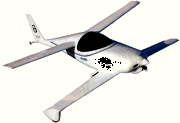 A sesquiplane configuration should allow the aircraft to have a shorter overall wingspan –a useful feature if landing on forested/jungle roads –or even just on roads with telegraph poles. Something similar is seen with the Rutan Quickie(left). Span of this plane is about 10ft less than biplanes of similar weight.
A sesquiplane configuration should allow the aircraft to have a shorter overall wingspan –a useful feature if landing on forested/jungle roads –or even just on roads with telegraph poles. Something similar is seen with the Rutan Quickie(left). Span of this plane is about 10ft less than biplanes of similar weight.
We'll call this new aircraft the “Shrike”.
Tactically Shrikes will operate in pairs. If one aircraft is downed the other can report its position. It is likely that one aircraft will be a “Sprayer” and the other a “Sweeper”. I was going to designate the second plane a “Shooter”, but this detracts from the fact that both aircraft should have some armament. Being less heavily burdened the Sweeper is used to locate and mark targets for the Sprayer. It also handles the bulk of air defence suppression duties.
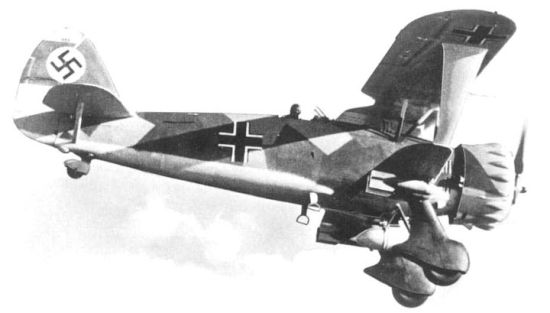
Another preceedent for this sort of aircraft is the Henschel Hs-123 (right), also a sesquiplane.
“A total of 604 Hs-123A-1s were built. By 1938, it was being phased out in first-line service, though one squadron continued to use it in the close-support role. It would serve in this role during the first years of World War II, fighting in the Polish, French, Balkan, and Soviet campaigns, and would prove an outstanding aircraft despite its somewhat antiquated design, being very rugged and able to operate under the worst conditions. It could take off from very muddy airfields if the landing-gear spats were removed. The Hs-123 proved devastatingly effective against enemy troop concentrations, attacking them with a load of two cluster-munition canisters, each filled 92 2 kilogram (4.4 pound) SD-2 antipersonnel fragmentation "butterfly bombs". The pilots learned that at a certain RPM the engine made a noise like machine-gun fire that terrorized troops on the ground. The Hs-123 could also carry the more traditional bombload of four SC 50 bombs on underwing racks, or an MG-FF 20 millimeter cannon in a pod under each wing; the centerline position was usually reserved for an external tank. Enthusiasm for the type was so great that even as late as 1943 there were calls that it should be put back into production.
Two prototypes of improved Hs-123 variants were built in 1938. The "Hs-123 V5" was a prototype for the "Hs-123B" series, featuring a further uprated BMW 132K engine with 716 kW (960 HP) in a longer cowling. It was followed by the "Hs-123 V6", which was the prototype for a projected "Hs-123C" series that was optimized for close support. The V6 featured the BMW 132K engine plus an enclosed cockpit, an armored headrest, and an extra machine gun under each wing.”
Note that the Hs-123 could be operated under conditions that grounded more modern (by 1940s standards) aircraft.
The prototype Arado AR81 biplane dive-bomber was considered to be superior in many respects to the Ju-87 Stuka that was adopted instead.
Some of the aerodymamic features developed to improve the STOL and low speed handling of the 260SE/STOL many also be applicable to the Shrike. In fact this aircraft may be a good basis to create the Shrike from
Threats to the Shrike.
Ground fire.
Machine guns, automatic cannon and SAMs have all be used against drug spraying planes. Defenses against these are the same as those used by COIN aircraft:- Armour, IR- and sound-suppression equipment, radar-warning receivers, chaff/flare launchers and IR jammers. The Shrike can be expected to be a very agile aircraft, and this will be useful against ground fire, as will be the armament and operating in pairs.
Air to Air Combat
Although it sounds a little "Hollywood", many drug barons have helicopters or light aircraft, and the possibility that these could be used against Sprayers cannot be discounted. The Shrike's armament and agility will prove useful against such threats.
Attack on the Ground.
In the area of operations it is not possible to greatly control civilian movement, nor is there likely to be manpower available to intensively patrol the area near an airstrip. What this means is that an armed man can get to within a couple of hundred metres of a parked aircraft. The armour of the Shrike will somewhat reduce the damage that a rifleman can do. The real answer is not to leave the aircraft in the open where someone can take shots at them. Shrikes should be deployed with an easily erected pre-fab hangers. Dummy hangers can also be set up. Chain link fence would be added to defend from RPGs and measures would be taken to defend against light mortars too.
The Shrike's ability to operate from roads and poorly prepared strips allows the aircraft to be operated from a wider choice of sites, making it harder for an enemy to catch the plane on the ground.
Another way to attack a grounded aircraft is by sabotage. Use of hangers also reduces the risk of this. Only trusted personnel are allowed into the hangers. To reduce sabotage it may be necessary to avoid using local mechanics.
Attacking the Pilot.
Assassination of pilots or trying to put them under duress by threatening their families is an obvious option for a drug baron. Ways to defend against this are beyond the scope of this page, but this possibility should be borne in mind.
UPDATE
Mike Sparks has also brought my attention to the German Equivalent of the Lysander, the Storch.
Many of the Short take-off features of the Storch could be incorporated in the Shrike. An unarmed version of the Shrike would be a good transport for a Flying Doctor and could incorporate the capability to move Stretcher-bound Invalids.
Another interesting Biplane is the An-2.
This is too slow for spraying guarded crops but may prove useful for other jobs in underdeveloped areas.
See here for another application for the Shrike

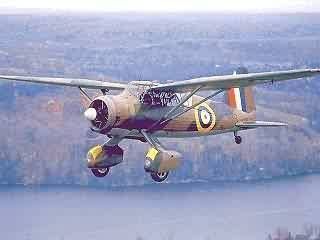


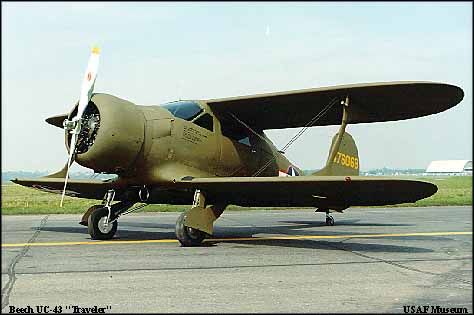
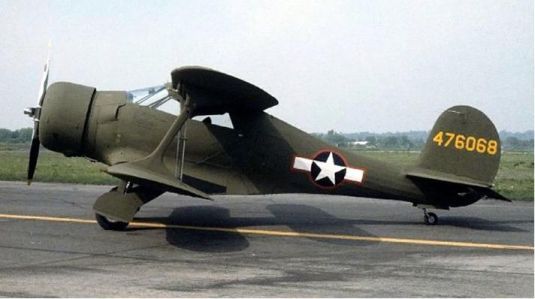
 A sesquiplane configuration should allow the aircraft to have a shorter overall wingspan –a useful feature if landing on forested/jungle roads –or even just on roads with telegraph poles. Something similar is seen with the Rutan Quickie(left). Span of this plane is about 10ft less than biplanes of similar weight.
A sesquiplane configuration should allow the aircraft to have a shorter overall wingspan –a useful feature if landing on forested/jungle roads –or even just on roads with telegraph poles. Something similar is seen with the Rutan Quickie(left). Span of this plane is about 10ft less than biplanes of similar weight.




